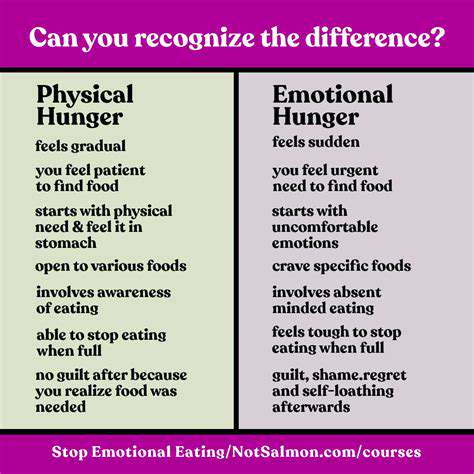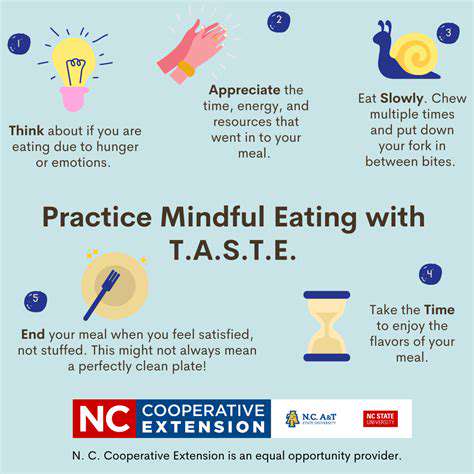close your eyes during the first few bites of a meal. Without visual distraction, your other senses heighten, revealing nuances you might otherwise miss. This simple practice can recalibrate your entire eating experience.Addressing Emotional Eating through Mindful Practices
Food often becomes our first responder to emotional distress. Mindful eating creates space to distinguish physical hunger from emotional craving. When the urge to eat arises, pause and scan your body. Is your stomach empty, or is your heart heavy? This moment of inquiry can reveal the true source of your appetite.
Developing alternative emotional regulation tools - like breathing exercises, creative expression, or nature immersion - provides healthier outlets than food. Over time, these practices rewire automatic responses, creating sustainable emotional resilience.
Identifying Emotional Eating Patterns
Understanding the Root Causes
Emotional eating patterns develop as coping mechanisms, often tracing back to childhood experiences. Many of us received food as comfort after scraped knees or bad days, establishing neural pathways that associate eating with emotional relief. As adults, these patterns operate beneath conscious awareness, activated by stress, loneliness, or overwhelm.
Journaling can illuminate these hidden connections. Note not just what you eat, but the circumstances surrounding emotional eating episodes. Over time, patterns emerge revealing your personal emotional triggers - certain times of day, specific relationships, or particular emotional states that reliably send you toward the pantry.
Recognizing Your Emotional Eating Triggers
Triggers often hide in plain sight. That mid-afternoon slump when work feels overwhelming. Those evenings when loneliness creeps in. The critical inner voice that whispers you'll never succeed. Each of these moments can become automatic triggers for emotional eating unless brought into conscious awareness.
Develop a trigger inventory - a running list of situations that precede emotional eating. Include physical locations (your kitchen after work), emotional states (frustration after arguments), or even specific foods that serve as emotional shortcuts. This awareness creates choice where habit once ruled.
Developing Healthy Coping Mechanisms
Replacing emotional eating requires developing an emotional first aid kit. Fill it with diverse tools: a playlist of uplifting songs, contact information for supportive friends, a list of quick physical activities, or creative outlets like coloring or journaling. Different situations call for different tools - having multiple options prevents falling back on food by default.
Experiment with brief mindfulness practices when cravings strike. Even ninety seconds of focused breathing can create enough space to choose a different response. The key lies in preparation - having alternatives ready before emotional storms hit.
Implementing Mindful Eating Practices
Transform your eating environment to support mindfulness. Designate a pleasant space for meals, free from digital intrusions. Use appealing dishware that pleases your senses. Begin each meal with a moment of gratitude - for the food, for your body's ability to enjoy it, for the hands that prepared it.
Practice the halfway check-in: pause when half your food remains. Assess your hunger levels. Often, we discover we're already comfortably satisfied and can choose to stop or slow down. This simple interruption breaks automatic eating patterns, creating space for conscious choice.

Strategies for Practicing Mindful Eating

Mindful Breathing Exercises
Mindful breathing serves as an anchor to the present moment. Before meals, try this simple practice: inhale deeply through your nose, noticing how the air feels cool entering your nostrils. Exhale slowly, feeling warmth as breath leaves your body. Just three of these conscious breaths can shift you from autopilot to awareness, creating the ideal mindset for mindful eating.
Experiment with counting breaths during meals - perhaps five mindful breaths between bites. This pacing technique naturally slows eating, allowing satiety signals to register before overeating occurs. Over time, these brief breathing pauses become natural rhythm markers in your eating experience.
Cultivating Non-Judgmental Awareness
Mindful eating isn't about perfect choices but about aware choices. When you notice judgment arising (I shouldn't be eating this), gently redirect to curiosity (What does this food truly offer me right now?). This shift from criticism to inquiry creates psychological safety around eating, reducing the shame that often perpetuates emotional eating cycles.
Practice observing cravings like weather patterns - they arise, change intensity, and eventually pass. This detached observation weakens their grip, allowing you to respond rather than react. You are not your cravings; you're the awareness that notices them.
Engaging in Mindful Movement
Physical activity can reset your relationship with hunger and fullness cues. Try a brief walk before meals, tuning into how movement affects your appetite. Notice how different activities - yoga, dancing, stretching - influence your connection with your body's signals. Movement creates interoceptive awareness, that internal sensitivity crucial for mindful eating.
After eating, gentle movement like walking or stretching aids digestion while maintaining mindful connection. Notice how different foods affect your energy and comfort during movement - these observations inform future food choices.
Integrating Mindfulness into Daily Activities
Mindfulness grows through consistent practice in ordinary moments. Wash dishes feeling the water's temperature and the dishes' textures. Fold laundry noticing fabrics' varied weights and weaves. These micro-practices train your attention muscle, making mindful eating more accessible when mealtimes arrive.
Create transition rituals between activities - perhaps three conscious breaths before entering the kitchen, or pausing to appreciate your food's colors before eating. These small anchors build a life of presence, with mindful eating as one natural expression.
Disclaimer: All articles on this site are original, please do not reprint

